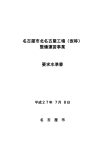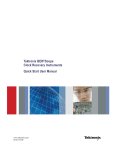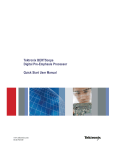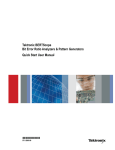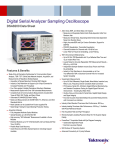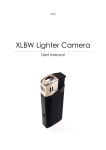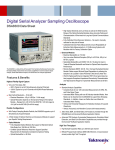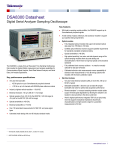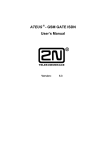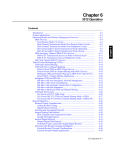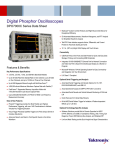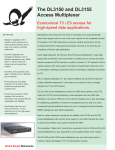Download CR286A User Manual
Transcript
x Tektronix BERTScope Clock Recovery Instruments ZZZ Quick Start User Manual *P071285201* 071-2852-01 xx Tektronix BERTScope Clock Recovery Instruments ZZZ Quick Start User Manual This document supports BSA Software V10 and above. www.tektronix.com 071-2852-01 Copyright © Tektronix. All rights reserved. Licensed software products are owned by Tektronix or its subsidiaries or suppliers, and are protected by national copyright laws and international treaty provisions. Tektronix products are covered by U.S. and foreign patents, issued and pending. Information in this publication supersedes that in all previously published material. Specifications and price change privileges reserved. TEKTRONIX and TEK are registered trademarks of Tektronix, Inc. Contacting Tektronix Tektronix, Inc. 14150 SW Karl Braun Drive P.O. Box 500 Beaverton, OR 97077 USA For product information, sales, service, and technical support: In North America, call 1-800-833-9200. Worldwide, visit www.tektronix.com to find contacts in your area. Warranty Tektronix warrants that this product will be free from defects in materials and workmanship for a period of one (1) year from the date of shipment. If any such product proves defective during this warranty period, Tektronix, at its option, either will repair the defective product without charge for parts and labor, or will provide a replacement in exchange for the defective product. Parts, modules and replacement products used by Tektronix for warranty work may be new or reconditioned to like new performance. All replaced parts, modules and products become the property of Tektronix. In order to obtain service under this warranty, Customer must notify Tektronix of the defect before the expiration of the warranty period and make suitable arrangements for the performance of service. Customer shall be responsible for packaging and shipping the defective product to the service center designated by Tektronix, with shipping charges prepaid. Tektronix shall pay for the return of the product to Customer if the shipment is to a location within the country in which the Tektronix service center is located. Customer shall be responsible for paying all shipping charges, duties, taxes, and any other charges for products returned to any other locations. This warranty shall not apply to any defect, failure or damage caused by improper use or improper or inadequate maintenance and care. Tektronix shall not be obligated to furnish service under this warranty a) to repair damage resulting from attempts by personnel other than Tektronix representatives to install, repair or service the product; b) to repair damage resulting from improper use or connection to incompatible equipment; c) to repair any damage or malfunction caused by the use of non-Tektronix supplies; or d) to service a product that has been modified or integrated with other products when the effect of such modification or integration increases the time or difficulty of servicing the product. THIS WARRANTY IS GIVEN BY TEKTRONIX WITH RESPECT TO THE PRODUCT IN LIEU OF ANY OTHER WARRANTIES, EXPRESS OR IMPLIED. TEKTRONIX AND ITS VENDORS DISCLAIM ANY IMPLIED WARRANTIES OF MERCHANTABILITY OR FITNESS FOR A PARTICULAR PURPOSE. TEKTRONIX' RESPONSIBILITY TO REPAIR OR REPLACE DEFECTIVE PRODUCTS IS THE SOLE AND EXCLUSIVE REMEDY PROVIDED TO THE CUSTOMER FOR BREACH OF THIS WARRANTY. TEKTRONIX AND ITS VENDORS WILL NOT BE LIABLE FOR ANY INDIRECT, SPECIAL, INCIDENTAL, OR CONSEQUENTIAL DAMAGES IRRESPECTIVE OF WHETHER TEKTRONIX OR THE VENDOR HAS ADVANCE NOTICE OF THE POSSIBILITY OF SUCH DAMAGES. [W2 – 15AUG04] Table of Contents Table of Contents General safety summary . . .. . .. . .. . .. . .. . .. . .. . .. . .. . .. . .. . .. . .. . .. . .. . .. . .. . .. . .. . .. . .. . .. . .. . .. . .. . .. . .. . .. . .. . .. . .. . .. . .. . .. . .. . .. . Compliance information .. . .. . .. . .. . .. . .. . .. . .. . .. . .. . .. . .. . .. . .. . .. . .. . .. . .. . .. . .. . .. . .. . .. . .. . .. . .. . .. . .. . .. . .. . .. . .. . .. . .. . .. . .. . .. . EMC compliance . . .. . .. . .. . .. . .. . .. . .. . .. . .. . .. . .. . .. . .. . .. . .. . .. . .. . .. . .. . .. . .. . .. . .. . .. . .. . .. . .. . .. . .. . .. . .. . .. . .. . .. . .. . .. . .. . Safety compliance. .. . .. . .. . .. . .. . .. . .. . .. . .. . .. . .. . .. . .. . .. . .. . .. . .. . .. . .. . .. . .. . .. . .. . .. . .. . .. . .. . .. . .. . .. . .. . .. . .. . .. . .. . .. . .. . Environmental considerations .. . .. . .. . .. . .. . .. . .. . .. . .. . .. . .. . .. . .. . .. . .. . .. . .. . .. . .. . .. . .. . .. . .. . .. . .. . .. . .. . .. . .. . .. . .. . .. . . Preface .. . .. . .. . .. . .. . .. . .. . .. . .. . .. . .. . .. . .. . .. . .. . .. . .. . .. . .. . .. . .. . .. . .. . .. . .. . .. . .. . .. . .. . .. . .. . .. . .. . .. . .. . .. . .. . .. . .. . .. . .. . .. . .. . Product description.. . .. . .. . .. . .. . .. . .. . .. . .. . .. . .. . .. . .. . .. . .. . .. . .. . .. . .. . .. . .. . .. . .. . .. . .. . .. . .. . .. . .. . .. . .. . .. . .. . .. . .. . .. . . . . Key specifications . .. . .. . .. . .. . .. . .. . .. . .. . .. . .. . .. . .. . .. . .. . .. . .. . .. . .. . .. . .. . .. . .. . .. . .. . .. . .. . .. . .. . .. . .. . .. . .. . .. . .. . .. . .. . .. . Documentation . .. . .. . .. . .. . .. . .. . .. . .. . .. . .. . .. . .. . .. . .. . .. . .. . .. . .. . .. . .. . .. . .. . .. . .. . .. . .. . .. . .. . .. . .. . .. . .. . .. . .. . .. . .. . .. . .. . Conventions used in this manual .. . .. . .. . .. . .. . .. . .. . .. . .. . .. . .. . .. . .. . .. . .. . .. . .. . .. . .. . .. . .. . .. . .. . .. . .. . .. . .. . .. . .. . .. . .. . .. . Installation.. . .. . .. . .. . .. . .. . .. . .. . .. . .. . .. . .. . .. . .. . .. . .. . .. . .. . .. . .. . .. . .. . .. . .. . .. . .. . .. . .. . .. . .. . .. . .. . .. . .. . .. . .. . .. . .. . .. . .. . .. . . . . Accessories . .. . .. . .. . .. . .. . .. . .. . .. . .. . .. . .. . .. . .. . .. . .. . .. . .. . .. . .. . .. . .. . .. . .. . .. . .. . .. . .. . .. . .. . .. . .. . .. . .. . .. . .. . .. . .. . .. . . . . Options .. . .. . .. . .. . .. . .. . .. . .. . .. . .. . .. . .. . .. . .. . .. . .. . .. . .. . .. . .. . .. . .. . .. . .. . .. . .. . .. . .. . .. . .. . .. . .. . .. . .. . .. . .. . .. . .. . .. . .. . .. . Operating requirements. .. . .. . .. . .. . .. . .. . .. . .. . .. . .. . .. . .. . .. . .. . .. . .. . .. . .. . .. . .. . .. . .. . .. . .. . .. . .. . .. . .. . .. . .. . .. . .. . .. . .. . .. . Preventing electrostatic discharge (ESD) .. . .. . .. . .. . .. . .. . .. . .. . .. . .. . .. . .. . .. . .. . .. . .. . .. . .. . .. . .. . .. . .. . .. . .. . .. . .. . .. . .. . .. . Instrument connection information . .. . .. . .. . .. . .. . .. . .. . .. . .. . .. . .. . .. . .. . .. . .. . .. . .. . .. . .. . .. . .. . .. . .. . .. . .. . .. . .. . .. . .. . .. . .. . Power on the instrument .. . .. . .. . .. . .. . .. . .. . .. . .. . .. . .. . .. . .. . .. . .. . .. . .. . .. . .. . .. . .. . .. . .. . .. . .. . .. . .. . .. . .. . .. . .. . .. . .. . .. . .. . Power off the instrument .. . .. . .. . .. . .. . .. . .. . .. . .. . .. . .. . .. . .. . .. . .. . .. . .. . .. . .. . .. . .. . .. . .. . .. . .. . .. . .. . .. . .. . .. . .. . .. . .. . .. . .. . BERTScopePC Software . . .. . .. . .. . .. . .. . .. . .. . .. . .. . .. . .. . .. . .. . .. . .. . .. . .. . .. . .. . .. . .. . .. . .. . .. . .. . .. . .. . .. . .. . .. . .. . .. . .. . .. . Operation. .. . .. . .. . .. . .. . .. . .. . .. . .. . .. . .. . .. . .. . .. . .. . .. . .. . .. . .. . .. . .. . .. . .. . .. . .. . .. . .. . .. . .. . .. . .. . .. . .. . .. . .. . .. . .. . .. . .. . .. . .. . .. . Front panel connectors and controls . . .. . .. . .. . .. . .. . .. . .. . .. . .. . .. . .. . .. . .. . .. . .. . .. . .. . .. . .. . .. . .. . .. . .. . .. . .. . .. . .. . .. . .. . .. . Rear panel connectors . . .. . .. . .. . .. . .. . .. . .. . .. . .. . .. . .. . .. . .. . .. . .. . .. . .. . .. . .. . .. . .. . .. . .. . .. . .. . .. . .. . .. . .. . .. . .. . .. . .. . .. . .. . Interface and display information .. . .. . .. . .. . .. . .. . .. . .. . .. . .. . .. . .. . .. . .. . .. . .. . .. . .. . .. . .. . .. . .. . .. . .. . .. . .. . .. . .. . .. . .. . .. . .. Use the Clock Recovery instrument with a Tektronix BERTScope Analyzer . . .. . .. . .. . .. . .. . .. . .. . .. . .. . .. . .. . .. . .. . .. . .. . .. Applications . .. . .. . .. . .. . .. . .. . .. . .. . .. . .. . .. . .. . .. . .. . .. . .. . .. . .. . .. . .. . .. . .. . .. . .. . .. . .. . .. . .. . .. . .. . .. . .. . .. . .. . .. . .. . .. . .. . .. . .. . .. Connect the Clock Recovery instrument to a Tektronix sampling oscilloscope . . .. . .. . .. . .. . .. . .. . .. . .. . .. . .. . .. . .. . .. . .. . .. Connect the Clock Recovery instrument to another Bit Error Rate Tester (BERT). . .. . .. . .. . .. . .. . .. . .. . .. . .. . .. . .. . .. . .. . .. User service. .. . .. . .. . .. . .. . .. . .. . .. . .. . .. . .. . .. . .. . .. . .. . .. . .. . .. . .. . .. . .. . .. . .. . .. . .. . .. . .. . .. . .. . .. . .. . .. . .. . .. . .. . .. . .. . .. . . . . .. . .. Service offerings . . .. . .. . .. . .. . .. . .. . .. . .. . .. . .. . .. . .. . .. . .. . .. . .. . .. . .. . .. . .. . .. . .. . .. . .. . .. . .. . .. . .. . .. . .. . .. . .. . .. . .. . .. . .. . .. General care. .. . .. . .. . .. . .. . .. . .. . .. . .. . .. . .. . .. . .. . .. . .. . .. . .. . .. . .. . .. . .. . .. . .. . .. . .. . .. . .. . .. . .. . .. . .. . .. . .. . .. . .. . .. . .. . .. . . . Preventive maintenance .. . .. . .. . .. . .. . .. . .. . .. . .. . .. . .. . .. . .. . .. . .. . .. . .. . .. . .. . .. . .. . .. . .. . .. . .. . .. . .. . .. . .. . .. . .. . .. . .. . .. . .. Connector replacement . .. . .. . .. . .. . .. . .. . .. . .. . .. . .. . .. . .. . .. . .. . .. . .. . .. . .. . .. . .. . .. . .. . .. . .. . .. . .. . .. . .. . .. . .. . .. . .. . .. . .. . .. Fuse replacement . .. . .. . .. . .. . .. . .. . .. . .. . .. . .. . .. . .. . .. . .. . .. . .. . .. . .. . .. . .. . .. . .. . .. . .. . .. . .. . .. . .. . .. . .. . .. . .. . .. . .. . .. . .. . .. Instrument calibration .. . .. . .. . .. . .. . .. . .. . .. . .. . .. . .. . .. . .. . .. . .. . .. . .. . .. . .. . .. . .. . .. . .. . .. . .. . .. . .. . .. . .. . .. . .. . .. . .. . .. . .. . . . Repack the instrument for shipment.. . .. . .. . .. . .. . .. . .. . .. . .. . .. . .. . .. . .. . .. . .. . .. . .. . .. . .. . .. . .. . .. . .. . .. . .. . .. . .. . .. . .. . .. . .. Specifications . . .. . .. . .. . .. . .. . .. . .. . .. . .. . .. . .. . .. . .. . .. . .. . .. . .. . .. . .. . .. . .. . .. . .. . .. . .. . .. . .. . .. . .. . .. . .. . .. . .. . .. . .. . .. . .. . .. . .. . . . Index CR125A, CR175A, CR286A Quick Start User Manual iii v v vi viii ix ix x xi xi 1 1 2 2 3 3 4 5 5 7 7 9 10 12 14 14 15 16 16 17 17 18 18 18 18 19 i Table of Contents ii CR125A, CR175A, CR286A Quick Start User Manual General safety summary General safety summary Review the following safety precautions to avoid injury and prevent damage to this product or any products connected to it. To avoid potential hazards, use this product only as specified. Only qualified personnel should perform service procedures. While using this product, you may need to access other parts of a larger system. Read the safety sections of the other component manuals for warnings and cautions related to operating the system. To avoid fire or personal injury Use proper power cord. Use only the power cord specified for this product and certified for the country of use. Connect and disconnect properly. Do not connect or disconnect probes or test leads while they are connected to a voltage source. Ground the product. This product is grounded through the grounding conductor of the power cord. To avoid electric shock, the grounding conductor must be connected to earth ground. Before making connections to the input or output terminals of the product, ensure that the product is properly grounded. Observe all terminal ratings. To avoid fire or shock hazard, observe all ratings and markings on the product. Consult the product manual for further ratings information before making connections to the product. The inputs are not rated for connection to mains or Category II, III, or IV circuits. Power disconnect. The power cord disconnects the product from the power source. Do not block the power cord; it must remain accessible to the user at all times. Do not operate without covers. Do not operate this product with covers or panels removed. Do not operate with suspected failures. If you suspect that there is damage to this product, have it inspected by qualified service personnel. Avoid exposed circuitry. Do not touch exposed connections and components when power is present. Wear eye protection. Wear eye protection if exposure to high-intensity rays or laser radiation exists. Do not operate in wet/damp conditions. Do not operate in an explosive atmosphere. Keep product surfaces clean and dry. Provide proper ventilation. Refer to the manual's installation instructions for details on installing the product so it has proper ventilation. CR125A, CR175A, CR286A Quick Start User Manual iii General safety summary Terms in this manual These terms may appear in this manual: WARNING. Warning statements identify conditions or practices that could result in injury or loss of life. CAUTION. Caution statements identify conditions or practices that could result in damage to this product or other property. Symbols and terms on the product These terms may appear on the product: DANGER indicates an injury hazard immediately accessible as you read the marking. WARNING indicates an injury hazard not immediately accessible as you read the marking. CAUTION indicates a hazard to property including the product. The following symbol(s) may appear on the product: iv CR125A, CR175A, CR286A Quick Start User Manual Compliance information Compliance information This section lists the EMC (electromagnetic compliance), safety, and environmental standards with which the instrument complies. EMC compliance EC Declaration of Conformity – EMC Meets intent of Directive 2004/108/EC for Electromagnetic Compatibility. Compliance was demonstrated to the following specifications as listed in the Official Journal of the European Communities: EN 61326-1 2006. EMC requirements for electrical equipment for measurement, control, and laboratory use. 1 2 3 CISPR 11:2003. Radiated and conducted emissions, Group 1, Class A IEC 61000-4-2:2001. Electrostatic discharge immunity IEC 61000-4-3:2002. RF electromagnetic field immunity IEC 61000-4-4:2004. Electrical fast transient / burst immunity IEC 61000-4-5:2001. Power line surge immunity IEC 61000-4-6:2003. Conducted RF immunity IEC 61000-4-11:2004. Voltage dips and interruptions immunity EN 61000-3-2:2006. AC power line harmonic emissions EN 61000-3-3:1995. Voltage changes, fluctuations, and flicker European contact. Tektronix UK, Ltd. Western Peninsula Western Road Bracknell, RG12 1RF United Kingdom 1 This product is intended for use in nonresidential areas only. Use in residential areas may cause electromagnetic interference. 2 Emissions which exceed the levels required by this standard may occur when this equipment is connected to a test object. 3 For compliance with the EMC standards listed here, high quality shielded interface cables should be used. CR125A, CR175A, CR286A Quick Start User Manual v Compliance information Australia / New Zealand Declaration of Conformity – EMC Complies with the EMC provision of the Radiocommunications Act per the following standard, in accordance with ACMA: CISPR 11:2003. Radiated and Conducted Emissions, Group 1, Class A, in accordance with EN 61326-1:2006. Australia / New Zealand contact. Baker & McKenzie Level 27, AMP Centre 50 Bridge Street Sydney NSW 2000, Australia Safety compliance EC Declaration of Conformity – Low voltage Compliance was demonstrated to the following specification as listed in the Official Journal of the European Communities: Low Voltage Directive 2006/95/EC. EN 61010-1: 2001. Safety requirements for electrical equipment for measurement control and laboratory use. U.S. Nationally Recognized Testing Laboratory listing UL 61010-1:2004, 2nd Edition. Standard for electrical measuring and test equipment. Canadian certification CAN/CSA-C22.2 No. 61010-1:2004. Safety requirements for electrical equipment for measurement, control, and laboratory use. Part 1. Additional compliances IEC 61010-1: 2001. Safety requirements for electrical equipment for measurement, control, and laboratory use. Equipment type Test and measuring equipment. Safety class Class 1 – grounded product. vi CR125A, CR175A, CR286A Quick Start User Manual Compliance information Pollution Degree description A measure of the contaminants that could occur in the environment around and within a product. Typically the internal environment inside a product is considered to be the same as the external. Products should be used only in the environment for which they are rated. Pollution Degree 1. No pollution or only dry, nonconductive pollution occurs. Products in this category are generally encapsulated, hermetically sealed, or located in clean rooms. Pollution Degree 2. Normally only dry, nonconductive pollution occurs. Occasionally a temporary conductivity that is caused by condensation must be expected. This location is a typical office/home environment. Temporary condensation occurs only when the product is out of service. Pollution Degree 3. Conductive pollution, or dry, nonconductive pollution that becomes conductive due to condensation. These are sheltered locations where neither temperature nor humidity is controlled. The area is protected from direct sunshine, rain, or direct wind. Pollution Degree 4. Pollution that generates persistent conductivity through conductive dust, rain, or snow. Typical outdoor locations. Pollution Degree Pollution Degree 2 (as defined in IEC 61010-1). Note: Rated for indoor use only. Installation (Overvoltage) category descriptions Terminals on this product may have different installation (overvoltage) category designations. The installation categories are: Measurement Category IV. For measurements performed at the source of low-voltage installation. Measurement Category III. For measurements performed in the building installation. Measurement Category II. For measurements performed on circuits directly connected to the low-voltage installation. Measurement Category I. For measurements performed on circuits not directly connected to MAINS. Overvoltage category Overvoltage Category II (as defined in IEC 61010-1) CR125A, CR175A, CR286A Quick Start User Manual vii Compliance information Environmental considerations This section provides information about the environmental impact of the product. Product end-of-life handling Observe the following guidelines when recycling an instrument or component: Equipment recycling. Production of this equipment required the extraction and use of natural resources. The equipment may contain substances that could be harmful to the environment or human health if improperly handled at the product’s end of life. To avoid release of such substances into the environment and to reduce the use of natural resources, we encourage you to recycle this product in an appropriate system that will ensure that most of the materials are reused or recycled appropriately. This symbol indicates that this product complies with the applicable European Union requirements according to Directives 2002/96/EC and 2006/66/EC on waste electrical and electronic equipment (WEEE) and batteries. For information about recycling options, check the Support/Service section of the Tektronix Web site (www.tektronix.com). Restriction of hazardous substances This product is classified as an industrial monitoring and control instrument, and is not required to comply with the substance restrictions of the recast RoHS Directive 2011/65/EU until July 22, 2017. viii CR125A, CR175A, CR286A Quick Start User Manual Preface Preface This document supports the following Tektronix BERTScope Clock Recovery instruments: CR125A with a maximum bit rate of 12.5 Gb/s CR175A with a maximum bit rate of 17.5 Gb/s CR286A with a maximum bit rate of 28.6 Gb/s NOTE. Faster instruments have higher specifications. Please contact your local Tektronix representative for additional details not mentioned in this document. The software-based graphical user interface is accessed through the Tektronix BERTScope Analyzer top level View menu, listed as Clock Recovery Control. Detailed information on the operation of the control interface can be accessed at any time through the Help menus available in any of the control views. BERTScopePC Standalone Software installs the Clock Recovery instrument control interface on a user-supplied PC. The BERTScopePC software is included on the CD-ROM shipped with the Clock Recovery instrument. The instrument communicates with the Tektronix BERTScope Analyzer or Host PC through a USB interface. A USB interconnect cable is provided with the product. Product description The Tektronix BERTScope CR125A, CR175A, and CR286A are fully flexible clock recovery instruments designed to make compliance testing of today’s communication designs easy and accurate. With jitter being such a complex and contentious parameter, the Tektronix Clock Recovery instrument is intended to make compliance testing simple, repeatable and accurate. Many communication standards now specify that jitter testing must be carried out using a reference clock that has been derived from the data signal using clock recovery with well defined loop bandwidth characteristics. Typically these characteristics are specified in terms of the -3 dB bandwidth of the recovery loop, the rate of roll-off of the frequency response, and the degree of response peaking allowable. These effects will greatly dictate the amount of jitter that will be present on the reference clock, and therefore the amount of jitter ultimately measured by test instrumentation. The Clock Recovery instrument has been designed from the ground up to provide flexibility and accuracy in compliance measurements. For easy verification of compliance, the correct characteristics are automatically set when a given standard is selected from a pull-down menu. However, for users wanting to explore the limits of their designs, full control of parameters is also easily available. A good example of this is for systems where restricting the buildup of jitter is critical. Clock recovery plays a crucial role in this, and the ability to emulate a clock recovery source with excessive peaking is a great way of understanding the system sensitivity to jitter gain. The Tektronix BERTScope Clock Recovery instrument is the perfect companion to the Tektronix BERTScope Bit Error Rate Analyzer, sharing a common user interface. A single USB connection and high quality microwave coax cables connect the two units. CR125A, CR175A, CR286A Quick Start User Manual ix Preface Table i: Features and benefits Features Benefits Accurate, robust (including spread spectrum clocking) clock recovery Recover clock when no device or system clock is available, jitter measurements cannot be any better than your clock reference. Accurate, user-controllable PLL bandwidth and peaking Compliant clock recovery for standards testing, measured DUT jitter is dependent on PLL bandwidth Optional jitter spectrum analysis Spectral view and measurement of jitter in signal, calibration of jitter components for PCIe 5 Gb/s receiver test Optional 24 MHz loop bandwidth For PCIe Gen 3 testing Key specifications Table ii: Key specifications Characteristic CR125A Data insertion loss Data input voltage range Measured edge density accuracy CR286A 100 mV single-ended 50 mV differential Input sensitivity (typical) Input data rate coverage CR175A 150 Mb/s to 12.5 Gb/s 150 Mb/s to 17.5 Gb/s 1 x CR286A Option HS 40 mV single-ended 20 mV differential 150 Mb/s to 28.6 Gb/s 150 Mb/s to 17.5 Gb/s 150 Mb/s to 28.6 Gb/s 2 dB (min), 2.6 dB (typical), 3 dB (max), up to 12.5 Gb/s 1 – –5 V (min), +5 V (max) –5 V (min), +5 V (max) 1 Vp-p (max) ±1%, up to 14.3 Gb/s, ±3% >14.3 Gb/s Equalization range Data output CR175A Option HS 0 to 10 dB Up to 12.5 Gb/s 1 – Data through path only recommended for use below 12.5 Gb/s. Use external pick-off tees and terminate output connector above 12.5 Gb/s. CR125A, CR175A, CR286A Quick Start User Manual Preface The following table lists the clock and subrate clock output characteristics and specifications common to all instruments: Table iii: Key specifications, clock and subrate clock outputs Characteristic Specifications Loop bandwidth 100 kHz-12 MHz, 200 kHz to 12 MHz above 14.3 GHz up to 24 MHz with Option XLBW ext. loop BW Peaking 0-6 dB, 500 kHz-12 MHz, 0-5 dB 12 MHz – 24 MHz with option XLBW Intrinsic jitter (typical) 250 fs Clock output range Full-rate clock for input data rates to 14.3 Gb/s Half-rate clock for input data rates >14.3 Gb/s Sub-rate divider ratios For input data rate to 14.3 Gb/s: Full rate divided by 1, 2, 4, 5, 6, 7, 8, 9, 10, 12, 14, 16, 18, 20, 24, 25, 28, 30, 32, 35, 36, 40, 42, 45, 48, 49, 50, 54, 56, 60, 63, 64, 70, 72, 80, 81, 90, 100, 108, 112, 120, 126, 128, 140, 144, 160, 162, 168, 180, 192, 196, 200, 216, 224, 240, 252, 256, 280, 288, 320, 324, 336, 360, 384, 392, 432, 448, 504, 512, 576, 648 For input data rate >14.3 Gb/s: Full rate divided by 2, 4, 8, 10, 12, 14, 16, 18, 20, 24, 28, 32, 36, 40, 48, 50, 56, 60, 64, 70, 72, 80, 84, 90, 96, 98, 100, 108, 112, 120, 126, 128, 140, 144, 160, 162, 180, 200, 216, 224, 240, 252, 256, 280, 288, 320, 324, 336, 360, 384, 392, 400, 432, 448, 480, 504, 512, 560, 576, 640, 648, 672, 720, 768, 784, 864, 896, 1008, 1024, 1152, 1296 Documentation In addition to this document, the following documents are available: Online help, including remote control commands Online remote control guide (PDF) Check the Tektronix Web site for additional documentation at www.tektronix.com/manuals. Conventions used in this manual The following icons are used throughout this manual. Sequence Step Front panel power Connect power Network PS2 SVGA USB NOTE. A Notice statement identifies conditions which can result in unintended operating modes, incorrect measurement results, or require resetting the operating software on a personal computer that interacts with the instrument. CR125A, CR175A, CR286A Quick Start User Manual xi Preface xii CR125A, CR175A, CR286A Quick Start User Manual Installation Installation Unpack the instrument and check that you have received all items listed as Standard Accessories. Check the Tektronix Web site (www.tektronix.com) for the most current information. The Tektronix Clock Recovery Instrument is intended to be operated in a controlled laboratory environment. The instrument is intended to operate on a bench top, or on top of another instrument such as the Tektronix BERTScope Bit Error Rate Analyzer. There are four shock-absorbing feet located on the bottom of the instrument. Operate the instrument only when positioned with the feet facing downward. Do not operate the instrument with the long axis vertical, standing on its side, as this will block the path of air required for cooling. CAUTION. Operating the instrument while it is standing on the side can damage and overheat the instrument. To avoid damaging the instrument or to avoid overheating the instrument, do not block any of the air vents to allow proper cooling during normal operation. This instrument uses a low voltage soft power switch that activates the power supply. The primary power control circuitry is always live whenever the power cable is connected to the mains. The instrument is fuse-protected to reduce the risk of fire in the event of a power supply failure. Access to the power cable for disconnection from the mains in an emergency may be required by local codes. CAUTION. To prevent damage to the instrument when the data outputs are not in use, terminate the data outputs with the SMA terminations provided. CAUTION. To prevent damage to the high sensitivity data circuitry, ensure that the input voltage does not exceed ±5 V range, 3 Vp-p. Accessories The instrument comes with the following standard accessories: Power cord USB interconnect cable Documents BERTScopePC Standalone Software CD-ROM (installs the CR’s control interface on a user-supplied PC) CR125A, CR175A, CR286A Quick Start User Manual 1 Installation The following optional accessories are available for your product: Accessory Description CR125ACBL High-performance delay matched cable set (required for BERTScope Analyzer and Clock Recovery instrument in SSC applications) 100PSRTFILTER 100 ps rise time filter BSA12500ISI Differential ISI board PMCABLE1M Precision phase-matched cable pair, 1 m SMAPOWERDIV SMA power dividers BSASATATEE BSA-SATA-Tee for OOB Signaling SATATESTSW Serial ATA Interop Test Suite automation software BSARACK BSA rack mount kits Options The following options are available for your product. Option Description CR125A CR175A CR286A PCIE PCIe PLL analysis (requires 12GJ, operates at 2.5 G and 5 G only) X X X PCIE8G PCIe PLL analysis (requires 12GJ, operates at 2.5 G, 5 G, and 8 G only) X X X HS Add high-sensitivity clock recovery X X X X XLBW Add extended loop bandwidth in the clock recovery X 12GJ Add jitter spectrum analysis from 1.2 to 11.2 Gb/s X 17GJ Add jitter spectrum analysis from 1.2 to 11.2 Gb/s 28GJ Add jitter spectrum analysis from 1.2 to 11.2 Gb/s X X Operating requirements Place the instrument on a cart or bench on the bottom feet or rear feet. Observe the following clearance requirements and dimensions: Table 1: Operating requirements Feature Description Top 0 mm (0 in) Left and right sides 76 mm (3 in) Bottom 0 mm (0 in) standing on feet, flip stands down Rear 0 mm (0 in) on rear feet Width 394 mm (15.5 in) Height 220 mm (8.7 in) Before operating the instrument, verify the ambient temperature: +10° C to +40 °C (+41 °F to +113 °F). 2 CR125A, CR175A, CR286A Quick Start User Manual Installation Preventing electrostatic discharge (ESD) CAUTION. To prevent damaging internal circuit boards and their components due to electrostatic discharge (ESD), please read the following guidelines. Electrostatic discharge (ESD) is a concern when handling any electronic equipment. The instrument is designed with robust ESD protection; however it is still possible that large discharges of static electricity directly into the signal input may damage the instrument. To avoid damage to the instrument, use the following guidelines to prevent electrostatic discharge to the instrument: Discharge the static voltage from your body by wearing a grounded antistatic wrist strap while connecting and disconnecting cables and adapters. The instrument provides a front panel connection for this purpose. Discharge any static voltage from all cables before connecting them to the instrument or device under test by momentarily grounding the center conductor of the cable, or by connecting a 50 Ω termination to one end, prior to attaching the cable to the instrument. A cable that is left unconnected on a bench can develop a large static charge. Nothing capable of generating or holding a static charge should be allowed on the work station surface. Instrument connection information The following diagram shows one of several ways of connecting the clock recovery instrument to a Tektronix BERTScope Analyzer; your connections may vary depending on your applications. Figure 1: Clock Recovery and BERTScope Analyzer connections CR125A, CR175A, CR286A Quick Start User Manual 3 Installation Power on the instrument 1. Connect the AC power cord to the rear of the instrument and to a properly grounded power source. 2. Push the front-panel power button to turn the instrument on. The green power indicator on the button will turn on. NOTE. The first time that the BERTScope Analyzer starts with the Clock Recovery instrument attached, the standard Microsoft Windows New Hardware Found message displays as the drivers automatically load. CAUTION. Static discharge can damage the instrument. To avoid static discharge while connecting cables to the front panel interface, always use the proper coaxial cables with APC-3.5, 2.92 mm, or SMA cables. 4 CR125A, CR175A, CR286A Quick Start User Manual Installation Power off the instrument 1. Press the front panel power button to turn the instrument off. The green power indicator on the button will turn off. 2. Disconnect the power cord from the rear of the instrument to completely remove power from the instrument after it shuts down. NEW DRAWING HERE BERTScopePC Software The BERTScope PC software provides for PC control of BERTScope Clock Recovery instruments and the Digital Pre-Emphasis Processor (DPP) instruments that are being operated as stand-alone instruments (not connected directly to a BERTScope bit error rate tester). With the BERTScopePC software installed on a Windows PC, and the stand-alone instrument connected to the PC via the standard USB interface, the BERTScopePC software initiates installation of the appropriate driver and provides a user interface allowing control of all DPP or CR functions. The user interface provided for each instrument is similar to the BERTScope bit error rate tester. Included in the installation is the BERTScope Remote Client application which provides for remote access to the BERTScopePC application. Also included is the CR firmware update tool. This software must be installed on a PC running the Windows XP Professional operating system. Insert the BERTScope PC disk in the disc drive of the PC and follow the on-screen instructions to install the software. After the software is installed, start the software from the Start menu by selecting Start > BERTScope > BERTScope PC UI (or one of the other selections in the menu). CR125A, CR175A, CR286A Quick Start User Manual 5 Installation 6 CR125A, CR175A, CR286A Quick Start User Manual Operation Operation Front panel connectors and controls Refer to the following illustration and table for information on the front panel connectors and controls. Adjust the input settings after connecting the cables to the Data Input and Clock Output connectors and turning the instrument on. Figure 2: Front panel connectors and controls Connectors/controls Description 1 Chassis ground Use this connector to connect a common ground to other instruments or to connect a ground strap with a banana connector to the instrument to reduce risk of static discharge while using the instrument. 2 DATA INPUT + and DATA INPUT – Data input connectors. Connect a differential input from a signal source to these connectors. To prevent damage to the high sensitivity data circuitry, ensure that the input voltage does not exceed ±5 V range, 3 Vp-p. 3 DATA OUTPUT + and DATA OUTPUT – Data output connectors. These are loop-through data differential data output connectors. Terminate any unused output connectors to avoid reflections that can severely degrade performance. 4 CLK OUT Clock output connector. This is the recovered full rate clock connector. 5 SUBRATE CLOCK Subrate clock connector. This is the recovered clock connector with programmable subrates. This signal can be connected to the trigger input of an oscilloscope. 6 Display The display shows measured values on the left side of the display and the device settings on the right side. The device settings can be controlled by buttons beneath the display and the rotary knob. CR125A, CR175A, CR286A Quick Start User Manual 7 Operation 8 Connectors/controls Description 7 Power On/Off button The power button activates the power supply to provide power to the primary circuits of the instrument. The switch has a green light when the instrument is powered on. The primary power control circuitry is always live whenever the power cord is connected to the instrument. To completely disconnect power from the instrument, disconnect the power cord a the rear of the instrument. 8 Adjustment knob The rotary knob adjusts the display settings and can scroll through the menu selections. It can also be used to zoom selections. 9 Lock button Push this button to initiate manual locking. 10 Lock status indicator The lock status indicator shows a different color for the status of the lock: Green, lock; Amber, locking; Red, unable to lock. 11 ESC button Push this button exit the submenus in the display and revert to the previous values when editing settings. 12 Left and right cursor buttons Push these buttons to navigate through the display settings. Use the buttons to move through and change individual digits; use the rotary knob to make larger changes. 13 Enter button Push this button to scroll through menus or to change digits when editing the display. It also selects the setting for adjustment and confirms changes when editing settings. CR125A, CR175A, CR286A Quick Start User Manual Operation Rear panel connectors Refer to the following illustration and table for information on the rear panel connectors. Figure 3: Rear panel connectors Connectors/controls Description 1 Chassis ground Use this connector to connect a common ground to other instruments. 2 AC Power Connect with a suitable power cable to match the local power outlet type. 3 USB IN USB 2.0 type B connector used to interface the instrument for control. When used with a BERTScope Analyzer, connect to any available USB connector. The instrument can also be operated standalone with an external PC. When operated in this mode, connect the USB connector to an available USB connector in the PC. The BERTScopePC software must be installed on the PC to support standalone operation. 4 USB HUB OUT Use these USB connectors to connect to other instruments in the system with USB cables. 5 RS232 Miniature type D connector for standard RS232 communication CR125A, CR175A, CR286A Quick Start User Manual 9 Operation Interface and display information Many industry standards are available from the front panel menu. The current settings appear on the right side of the display. The following table shows settings that you can enter manually. Table 2: Display settings Item Description Nominal Data Rate Nominal rate of the recovered clock Lock Range Frequency range around the nominal rate that will be scanned during locking Bandwidth Bandwidth of the recovery loop measured at –3 dB Peaking Peaking of the recovery loop. Also sets first or second order roll-off of untracked jitter Nominal Edge Density Expected edge density of incoming data. Required to set bandwidth correctly Edge Density Mode Sets bandwidth. Calculations are based on Nominal Edge Density or edge density measured during lock Clock Amplitude Output amplitude of the full rate clock Subrate Amplitude Output amplitude of the subrate clock Subrate Division Division ratio of the subrate clock By default, all settings will be saved automatically when you power off the instrument will be restored when you turn the instrument on. You can save current settings to one of four setups to be recalled later. Several continuously updated measurements are shown on the front panel display. Figure 4: Measured values 10 CR125A, CR175A, CR286A Quick Start User Manual Operation The following table describes the displayed measurements. Table 3: Displayed measurements Item Description Data rate The actual input data rate in Hertz. If the CR platform has DDR capability (such as the CR2500A), the CR Monitor data rate will be displayed in Gb/s or Mb/s. Edge Density (EdgeD) The measured edge density. A ‘1010’ data pattern transmitted at the Nominal Data Rate would have 100% edge density. Phase Error The peak-to-peak phase error between the incoming data and the recovered clock. This measured value will increase if jitter is present on the input data that is not being tracked by the recovered clock. Phase Error RMS (PhErms) The RMS phase error between the incoming data and the recovered clock Lock Status Reports whether the CR is locked, unlocked, or in the process of locking. By default, the instrument is configured in Auto Lock mode, where it automatically attempts to acquire lock if the detected Phase Error exceeds the Phase Error Limit setting, or if the recovered clock is unstable. Pressing the LOCK key on the CR front panel forces a relock. CR125A, CR175A, CR286A Quick Start User Manual 11 Operation Use the Clock Recovery instrument with a Tektronix BERTScope Analyzer This section provides information on using the Clock Recovery instrument with a Tektronix BERTScope Analyzer. The Clock Recovery instrument can be connected to a Tektronix BERTScope Analyzer through a USB cable, allowing full control of the instrument through the BERTScope Analyzer touchscreen user interface. The following setup is one of many ways of connecting the instruments. Your system configuration will vary. The following steps are provided as guidelines for connecting the Clock Recovery instrument to a Tektronix BERTScope Analyzer. Refer to the connection diagram as needed. Figure 5: Connecting the Clock Recovery instrument to a Tektronix BERTScope Analyzer 1. Connect a USB cable from the rear of the Clock Recovery instrument to the BERTScope Analyzer. 2. Connect the Clock Recovery data input connectors to the BERTScope Analyzer Pattern Generator data output connectors. 3. Connect the Clock Recovery data output connectors to the BERTScope Analyzer data input connectors. 4. Connect the Clock Recovery clock output to the BERTScope Analyzer clock input. 5. Power on the BERTScope Analyzer and then the Clock Recovery instrument. 12 CR125A, CR175A, CR286A Quick Start User Manual Operation After the BERTScope Analyzer completes the start-up sequence, the Home view will appear. Figure 6: BERTScope Analyzer Home view Press View on the BERTScope Analyzer, select Clock Recovery followed by CR Control to access the CR Control view. Figure 7: Clock Recovery CR Control view Use the buttons on the touchscreen to access the device settings; all functionality is available through the user interface as well as the front panel controls of the Clock Recovery instrument. Graphing capability is available on the Tektronix BERTScope Analyzer by pressing the oval To CR Analysis button at the top of the BERTSCope Analyzer Clock Recovery Control display (this Clock Recovery Analysis view can also be selected from the initial View menu). CR125A, CR175A, CR286A Quick Start User Manual 13 Applications Applications To connect to another instrument, here are some simple configurations to get you started. Connect the Clock Recovery instrument to a Tektronix sampling oscilloscope Complete the following steps to connect the clock recovery instrument to a Tektronix sampling oscilloscope. Figure 8: Connecting the Clock Recovery instrument to a Tektronix sampling oscilloscope 1. Connect the data input connections from the signal under test to the Data Input connectors on the Clock Recovery instrument. 2. Connect the Clock Recovery Data Output connectors to the data input connection on the sampling oscilloscope. 3. Connect the Clock Recovery Clock Output connectors to the trigger input connector of the sampling oscilloscope. 14 CR125A, CR175A, CR286A Quick Start User Manual Applications Connect the Clock Recovery instrument to another Bit Error Rate Tester (BERT) Complete the following steps to connect the Clock Recovery instrument to another Bit Error Rate Tester. The actual connections depend on your instrument. Figure 9: Connecting the Clock Recovery instrument to another BERT instrument 1. Connect the pattern generator data output connectors from the BERT instrument to the Clock Recovery Data Input connectors. 2. Connect the Error Detector data input connectors from the BERT instrument to the Clock Recovery Data Output connectors. 3. Connect the Clock Input connector from the BERT instrument to the Clock Recovery Clock Output connectors. CR125A, CR175A, CR286A Quick Start User Manual 15 User service User service This section describes high-level service and maintenance information for your instrument. Service offerings Tektronix provides service to cover repair under warranty as well as other services that are designed to meet your specific service needs. Whether providing warranty repair service or any of the other services listed below, Tektronix service technicians are well equipped to service the instruments. Services are provided at Tektronix Service Centers and on-site at your facility, depending on your location. Warranty repair service Tektronix warrants this product as described in the warranty statements at the front of this manual. Tektronix technicians provide warranty service at most Tektronix service locations worldwide. The Tektronix product catalog lists all service locations worldwide. Calibration and repair service In addition to warranty repair, Tektronix Service offers calibration and other services that provide cost-effective solutions to your service needs and quality standards compliance requirements. Our instruments are supported worldwide by the leading-edge design, manufacturing, and service resources of Tektronix to provide the best possible service. 16 CR125A, CR175A, CR286A Quick Start User Manual User service General care Protect the instrument from adverse weather conditions. The instrument is not waterproof. Do not store or leave the instrument where the display will be exposed to direct sunlight for long periods of time. CAUTION. To avoid damage to the instrument, do not expose it to sprays, liquids, or solvents. Preventive maintenance Preventive maintenance mainly consists of periodic cleaning. Periodic cleaning reduces instrument breakdown and increases reliability. Clean the instrument as needed, based on the operating environment. Dirty conditions may require more frequent cleaning than computer room conditions. Exterior cleaning Clean the exterior surfaces with a dry, lint-free cloth or a soft-bristle brush. If dirt remains, use a cloth or swab dampened with a 75% isopropyl alcohol solution. A swab is useful for cleaning in narrow spaces around the controls and connectors. Do not use abrasive compounds on any part of the instrument. Cleaning guidelines Avoid getting moisture inside the instrument during external cleaning and use only enough solution to dampen the cloth or swab. Do not wash the front-panel On/Standby switch. Cover the switch while washing the instrument. Use only deionized water when cleaning. Use a 75% isopropyl alcohol solution as a cleanser and rinse with deionized water. Do not use chemical cleaning agents; they may damage the instrument. Avoid chemicals that contain benzene, toluene, xylene, acetone, or similar solvents. CR125A, CR175A, CR286A Quick Start User Manual 17 User service Connector replacement The DATA IN and DATA OUT connectors use Planar Crown® adapters. These facilitate user replacement of the adapter, should it become damaged. Replacement adapters can be ordered from Tektronix. Replace the front panel connectors The adapter is secured to the connector with a captive threaded mounting ring. 1. Remove a damaged connector by grasping the knurled outer portion of the ring with your fingers and turning counter-clockwise. Do not allow foreign material to enter the connector body when replacing the adapter. 2. Position the two locating tabs in the corresponding slots of the instrument-mounted portion of the connector and seat the replacement adapter. 3. Align the retaining ring and tighten by rotating clockwise. Tightened the connector finger-tight. To avoid over-tightening and possibly damaging the connector, do not use a tool to tighten it. Fuse replacement The instrument is protected by a fuse placed in series with the power line input. The fuse is conservatively rated and should never open through the life of the instrument. A blown fuse would generally indicate a problem with the instrument which requires factory service. It is recommended that you arrange to have the instrument serviced if you experience a blown fuse. Instrument calibration The instrument uses digital calibration of the output buffers. To maintain the accuracy of the output amplitude and offset, annual calibration is recommended. Contact Tektronix to schedule instrument calibration. Repack the instrument for shipment If the instrument is to be shipped to a Tektronix service center for repair, attach a tag showing the following information: Name of the product owner Address of the owner Instrument serial number A description of the problems encountered and/or service required When packing an instrument for shipment, use the original packaging. If it is unavailable or not fit for use, contact your Tektronix representative to obtain new packaging. 18 CR125A, CR175A, CR286A Quick Start User Manual Specifications Specifications Table 4: Data specifications Characteristic Description Data interfaces 50 Ω differential or single-ended, DC-Coupled APC 3.5mm user-replaceable Planar Crown® adapters Data rate coverage CR125A 150 Mb/s to 12.5 Gb/s CR175A 1 150 Mb/s to 17.5 Gb/s CR286A 1 150 Mb/s to 28.6 Gb/s Data insertion loss 2 dB (min), 2.6 dB (typical), 3 dB (max) from data input to data output Data input voltage range –5 V (min), +5 V (max) Input sensitivity 100 mV single ended (typical) 50 mV differential (typical) Measured edge density resolution ±1% Measured phase deviation Displayed as % RMS and % peak-peak, 10-90% peak-peak available range 1 Includes specifications for Option HS Table 5: Clock specifications Characteristic Description Clock interfaces 50 Ω single-ended, AC Coupled. APC 3.5 mm user-replaceable Planar Crown® adapters Clock output range 150 MHz to 12.5 GHz (full rate clock output) Loop bandwidth 2.5 kHz to 12 MHz variable Loop bandwidth accuracy ±10% (1100 pattern) Locking range 50 MHz default, adjustable to 10 to 500 MHz Peaking 0-6 dB from 500 kHz to 12 MHz 0 dB from 100 kHz to 500 kHz Peaking accuracy Greater of ±10% of setting, or 0.5 dB Frequency response roll-off –20 dB/ decade to –40 dB/decade Intrinsic jitter (typical) 70 fs (typical), 250 fsRMS (max), measured at 800 mVp-p input amplitude, 10 Gb/s, 1010 pattern, 2 MHz loop bandwidth setting, and 0.5 dB peaking Output frequency deviation tracking range (tracking 30 to 33 kHz triangle modulated SSC) +500/–5500 ppm (+0.05/–0.55%) Minimum input return loss 15 dB Output waveform rise/fall times (20/80%) 25 ps (typical), 30 ps (max) Clock output amplitude 250 mVp-p (min) 900 mVp-p (max) at clock rates ≤12.5 Gb/s 700 mVp-p (max) at clock rates >12.5 Gb/s Output amplitude setting accuracy Greater of 10% or 30 mV, >50 MHz clock output frequency CR125A, CR175A, CR286A Quick Start User Manual 19 Specifications Table 5: Clock specifications (cont.) Characteristic Description Subrate clock output (as specified for clock output except for the following) Subrate divider ratios Full rate divided by 1, 2, 4, 5, 6, 7, 8, 9, 10, 12, 14, 16, 18, 20, 24, 25, 28, 30, 32, 35, 36, 40, 42, 45, 48, 49, 50, 54, 56, 60, 63, 64, 70, 72, 80, 81, 90, 100, 108, 112, 120, 126, 128, 140, 144, 160, 162, 168, 180, 192, 196, 200, 216, 224, 240, 252, 256, 280, 288, 320, 324, 336, 360, 384, 392, 432, 448, 504, 512, 576, 648 Table 6: Trigger information (rear panel) Characteristic Description Trigger output Interface type SMA, 50 Ω, DC coupled Latency 300 ms Trigger input Interface type SMA, 50 Ω, DC-coupled to 0 V Threshold 1.5 V Minimum pulse width 50 ns Table 7: General specifications Characteristic Description Device information Serial number, revision codes available using front-panel Control interface USB cable (supplied). Unit also provides hub capability for 3 additional USB ports. Table 8: Physical specifications 20 Characteristic Description Height 9.5 cm (3.75 in) Width 39.4 cm (15.5 in) Depth 33.6 cm (13.25 in) Weight 9.1 kg (20 lbs) Power 150 W maximum Voltage 100 to 240 VAC, 50/60 Hz Power fuse 3.15 A, 250 V, 5 mm x 20 mm, fast blow CR125A, CR175A, CR286A Quick Start User Manual Specifications Table 9: Environmental specifications Characteristic Description Temperature Operating +10 °C to +40 °C (+41 °F to +113 °F) Non-operating −20 °C to +60 °C Humidity Operating 20 to 80% at or below 40 °C Non-operating 5 to 90% at or below 60 °C The performance of the BERTScope CR Series Option GJ Jitter Spectrum and DCD measurements are listed in the following tables. The performance of the clock recovery functionality remains identical as listed in the BERTScope CR series specifications. Table 10: Jitter spectrum Characteristic Description Minimum frequency 200 Hz Maximum frequency 90 MHz Minimum frequency resolution 200 Hz Maximum jitter Limited only by the ability of the clock recovery to lock with PLL BW at 0.5 MHz and 0.5 dB peaking Vertical units % UI or ps Vertical scale Log or linear Frequency scale Log or linear Maximum number of integrated measurement frequency bands 3 Table 11: Duty cycle-dependent jitter Characteristic Description Units % UI or ps Maximum range 50% UI CR125A, CR175A, CR286A Quick Start User Manual 21 Specifications 22 CR125A, CR175A, CR286A Quick Start User Manual Index Index A D accessories optional, 2 standard, 1 adapters, 18 auto lock mode, 11 data input connectors, 7 data output connector termination, 1 data output connectors, 7 data rate, 11 data specifications, 19 dimensions, 2 display measurements, 11 settings, 10 B bandwidth, 10 benefits, x BERTScope Analyzer connections, 12 setups, 13 BERTScope PC software, 5 BERTScope remote client, 5 BERTScopePC application, 5 bit error rate tester connections, 15 E edge density, 11 edge density mode, 10 environmental specifications, 21 ESD preventing, 3 exterior cleaning, 17 C F calibration, 16, 18 cleaning exterior, 17 guidelines, 17 clearance requirements, 2 clock amplitude, 10 output connector, 7 specifications, 19 subrate connector, 7 connections BERTScope Analyzer, 12 bit error rate tester, 15 sampling oscilloscope, 14 connector termination, 1 connectors front panel, 7 rear panel, 9 replacing, 18 controls, 7 CR Control view, 13 CR125A, ix CR175A, ix CR286A, ix features, x front panel connectors, 7 controls, 7 fuse, 18 lock status, 11 lock status indicator, 8 M maintenance cleaning, 17 preventive, 17 maintenance information, 16 N nominal data rate, 10 nominal edge density, 10 O operating requirements, 2 optional accessories, 2 options, 2 output connector termination, 1 P PC input voltage precautions, 1 installation, 1 pre-requisites, 5 PC software, 5 peaking, 10 phase error Pk-Pk, 11 RMS, 11 physical specifications, 20 power-off procedure, 5 power-on procedure, 4 preventive maintenance, 17 product options, 2 J R H Home view, 13 I jitter spectrum specifications, 21 K key specifications, x L LOCK key, 11 lock range, 10 CR125A, CR175A, CR286A Quick Start User Manual rear panel connectors, 9 S Safety Summary, iii sampling oscilloscope connections, 14 service offerings, 16 23 Index settings display, 10 specifications, 19 clock, 19 data, 19 environmental, 21 general, 20 jitter spectrum, 21 key, x physical, 20 trigger, 20 24 standard accessories, 1 subrate amplitude, 10 clock connector, 7 division, 10 W warranty repair, 16 warranty service, 16 T terminating data output connectors, 1 trigger specifications, 20 CR125A, CR175A, CR286A Quick Start User Manual










































